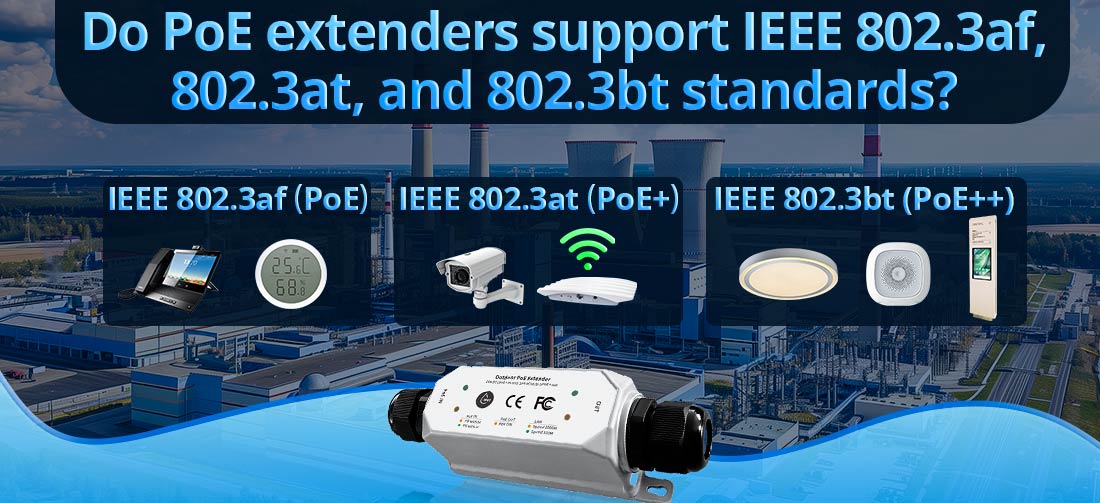
¿Los extensores PoE son compatibles con los estándares IEEE 802.3af, 802.3at y 802.3bt?
Sí, muchos extensores PoE admiten los estándares IEEE 802.3af, 802.3at y 802.3bt. Sin embargo, la compatibilidad exacta con estos estándares depende del modelo específico del extensor PoE. A continuación se muestra un desglose detallado de estos estándares y cómo se relacionan con los extensores PoE:
1.IEEE 802.3af (PoE)
Entrega de energía:
--- Salida de potencia máxima: 15,4 W por puerto.
--- El estándar 802.3af es adecuado para alimentar dispositivos de potencia baja a moderada, como teléfonos IP, cámaras IP básicas y pequeños puntos de acceso inalámbrico (WAP).
Compatibilidad del extensor PoE:
--- La mayoría de los extensores PoE son compatibles con IEEE 802.3af, ya que es el estándar PoE más utilizado en la industria.
--- Estos extensores generalmente están diseñados para proporcionar suficiente energía y transmisión de datos para dispositivos con demandas de energía baja a media (por ejemplo, cámaras pequeñas o teléfonos VoIP).
Casos de uso:
--- Cámaras IP: Modelos básicos que no requieren alta potencia (por ejemplo, cámaras de 720p o 1080p).
--- Teléfonos VoIP: Teléfonos con consumo de energía moderado.
--- Dispositivos de bajo consumo: dispositivos como pequeños sensores, intercomunicadores y sistemas simples de control de acceso.
2. IEEE 802.3at (PoE+)
Entrega de energía:
--- Salida de potencia máxima: 25,5 W por puerto, lo que proporciona más potencia que 802.3af.
--- Este estándar está diseñado para alimentar dispositivos con mayores requisitos de energía, como cámaras con giro, inclinación y zoom (PTZ), puntos de acceso inalámbricos más potentes u otros dispositivos de red que necesitan más de 15,4 W.
Compatibilidad del extensor PoE:
--- 802.3at (PoE+) también es ampliamente compatible con Extensores PoE. Estos extensores pueden transmitir la potencia y los datos necesarios para dispositivos de potencia media a alta, como cámaras IP avanzadas y puntos de acceso.
--- Los extensores PoE que admiten PoE+ son ideales para aplicaciones que requieren un mayor presupuesto de energía o tendidos de cable más largos.
Casos de uso:
--- Cámaras IP PTZ: Estas cámaras requieren mayor potencia para los motores, el zoom y las funciones de giro e inclinación.
--- Puntos de acceso inalámbrico (WAP): puntos de acceso modernos que requieren más energía para mejorar la cobertura y el rendimiento de Wi-Fi (por ejemplo, estándares 802.11ac o 802.11ax).
--- Sistemas de iluminación LED: sistemas de iluminación inteligentes que requieren más energía para funciones avanzadas como control de color y atenuación.
3. IEEE 802.3bt (PoE++/Ultra PoE)
Entrega de energía:
--- Tipo 3 (PoE++): 60W por puerto.
--- Tipo 4 (PoE++ o Ultra PoE): 100W por puerto.
--- Este es el estándar más reciente y potente en tecnología PoE, que admite dispositivos de alta potencia como grandes cámaras con giro, inclinación y zoom (PTZ), puntos de acceso inalámbricos de alta gama e incluso señalización digital, sistemas de edificios inteligentes e industriales. automatización.
Compatibilidad del extensor PoE:
--- Algunos extensores PoE, especialmente los modelos de alta potencia, son compatibles con IEEE 802.3bt (PoE++), incluidos los tipos 3 y 4, lo que les permite proporcionar hasta 100 W de potencia.
--- Estos extensores pueden alimentar dispositivos más exigentes, incluidos los utilizados en aplicaciones industriales, comerciales y de IoT. Sin embargo, no todos los extensores PoE admiten PoE++ debido a los mayores requisitos de energía y el manejo de energía más complejo.
Casos de uso:
--- Cámaras IP de alta potencia: cámaras de alta definición con capacidades PTZ o cámaras con calentadores incorporados u otras funciones que consumen mucha energía.
--- Iluminación LED: Sistemas de iluminación inteligentes a gran escala para entornos industriales o exteriores.
--- Señalización Digital y Kioscos: Dispositivos que requieren mayor potencia para pantallas, procesadores y periféricos.
--- Dispositivos industriales de IoT: dispositivos que requieren más de 30 W para sensores, controladores y actuadores avanzados.
4. Cómo los extensores PoE manejan los diferentes estándares
Los extensores PoE están diseñados para detectar automáticamente el estándar PoE (af, at o bt) de la fuente y proporcionar el nivel de energía adecuado al dispositivo conectado. Así es como los extensores PoE gestionan estos estándares:
Compatibilidad con versiones anteriores:
--- 802.3bt es compatible con versiones anteriores de 802.3at y 802.3af. Esto significa que un extensor PoE que admita 802.3bt también puede manejar dispositivos 802.3af o 802.3at sin problemas. Sin embargo, la potencia de salida estará limitada a los requisitos del dispositivo conectado.
Gestión de energía:
--- Los extensores regularán y distribuirán la energía de acuerdo con el máximo disponible desde el inyector o conmutador PoE de la fuente. Por ejemplo, si un conmutador de fuente solo admite 802.3af, el extensor seguirá proporcionando 15,4 W, incluso si es capaz de admitir 802.3at o 802.3bt.
Consideraciones de cableado:
--- La calidad del cable Ethernet también afecta la cantidad de energía que se puede entregar de manera efectiva, especialmente a distancias más largas. Se recomiendan cables de alta calidad como Cat 5e o Cat 6 para garantizar una entrega de energía óptima, especialmente con dispositivos 802.3bt.
5. Conclusión
De hecho, los extensores PoE pueden admitir IEEE 802.3af (PoE), 802.3at (PoE+) y 802.3bt (PoE++) estándares, pero la compatibilidad exacta dependerá del modelo y los requisitos de energía de los dispositivos conectados.
--- IEEE 802.3af: Adecuado para dispositivos básicos de bajo consumo como teléfonos IP y cámaras simples. Compatible con la mayoría de los extensores.
--- IEEE 802.3at: Admite dispositivos de mayor potencia como cámaras PTZ y WAP más robustos. Ampliamente compatible con extensores PoE.
--- IEEE 802.3bt: el estándar más reciente y potente, que proporciona hasta 100 W por puerto. Compatible con extensores PoE de alta potencia, pero no todos los extensores ofrecen funcionalidad PoE++.
Al seleccionar un extensor PoE, asegúrese de que coincida con los requisitos de energía de sus dispositivos y admita el estándar PoE necesario para garantizar un rendimiento y una entrega de energía óptimos.